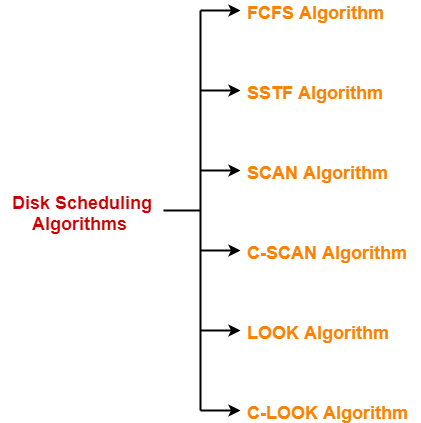First Come First Serve FCFS is an operating system scheduling algorithm that automatically executes queued requests and processes in order of their arrival. There are many different criteria to check when considering the best scheduling algorithm they are.

Process Scheduling Algorithms In The Operating System
FCFS first-come-first-serve disk scheduling algorithm.

. 1 See answer. Medium-term scheduling is a part of swapping. 100 Instructions to the candidates.
Six types of process scheduling algorithms are. Shortest Remaining time SRT algorithm. TYPES OF DISK SCHEDULING ALGORITHMS.
A Scheduling Algorithm is the algorithm which tells us how much CPU time we can allocate to the processes. Different Scheduling Algorithms. In the First Come First Serve method the process which requests the CPU gets the CPU allocation first.
Simplest scheduling algorithm that schedules according to arrival times of processes. FCFS Scheduling SJF Scheduling Round Robin Scheduling Example with Gantt Chart SRTF Scheduling and Priority Scheduling example. 1 Answers to the two sections should be written in separate.
Explain different disk scheduling algorithms with example. In this type of algorithm processes which requests the CPU first get the CPU allocation first. There are different types of disk scheduling algorithms.
Hold and wait There must be one process holding one resource and waiting for another resource 3. The purpose of this material is to provide one with help on disk scheduling algorithms. CPU scheduling is divided into two types.
Shortest Seek Time First SSTF DIAGRAM. CPU scheduler selects a process among the processes that are ready to execute and allocates CPU to one of them. Disk Scheduling Algorithms are used to reduce the total seek time of any request.
You should now have an understanding as to why your operating system truly relies on the type of algorithm it needs when it is dealing with multiple processes. Mutual exclusion At least one resource must be held in a non-sharable mode. This is managed with a FIFO queue.
Both processes are scheduled by the different scheduling algorithm. Ie only one instance 2. Preemptive Scheduling Algorithms are those which are based on the priority of the processes.
Short-term schedulers also known as dispatchers make the decision of which process to execute next. No preemption Resources cannot be preempted Ie critical sections cannot be aborted externally 4. By preference when a high priority process enters it preempts a low priority process in between.
It is implemented by using the FIFO queue. The limitation of each algorithm leads to the evolution of a new algorithm. Huffman Coding and Dijkstras algorithm are two prime examples where the Greedy algorithm is used.
Explain different types of scheduling algorithms in brief. First come first serve scheduling algorithm states that the process that requests the CPU first is allocated the CPU first. Information Technology Semester - II PROGRAMMING PARADIGMS 2008 Pattern Time.
The list of various disks scheduling algorithm is given below. Preemptive priority Scheduling algorithm. First-come first-served scheduling FCFS algorithm.
Shortest Job First Scheduling SJF algorithm. Ans- The Scheduling policy determines when it is time for process to be removed from the CPU and which ready process should be allocated the CPU next. So the disk scheduling algorithm that gives minimum rotational latency is better.
SSTF shortest seek time first disk scheduling algorithm. SCAN disk scheduling algorithm. Each algorithm contains its own benefits and drawbacks.
List of scheduling algorithms are as follows. SSTF shortest seek time first algorithm. It assigns a variable-length encoding for each character.
This is the worse algorithm that one can use. Process Scheduling Algorithms Edit. LOOK disk scheduling algorithm.
Separate queues used for foreground and background processes. Some Algorithms that are based on preemptive scheduling are Round Robin Scheduling RR Shortest Remaining Time First SRTF Priority preemptive version Scheduling etc. Foreground process used RR algorithm and background process used FCFS algorithm.
Each algorithm is carrying some advantages and disadvantages. B Explain different disk scheduling algorithms with example. These scheduling algorithms are either preemptive or non-preemptive.
Hopefully with this one will be able to get a stronger grasp of what disk scheduling algorithms do. Transfer time is the time to transfer the data. Non-preemptive priority Scheduling algorithm.
First Come First Serve FCFS 2 Shortest-Job-First SJF Scheduling 3 Shortest Remaining Time 4 Priority Scheduling 5 Round Robin Scheduling 6 Multilevel Queue Scheduling. C-SCAN disk scheduling algorithm. Ans 5a Three most basic scheduling algorithms and difference between them are- Shortest Time FirstSTF Longest Time FirstLTF Round Robin RR Process with least execution time will be executed first Available Process with highest execution time View the full answer.
Lets us discuss an example of Multilevel Queue Scheduling with five queues having a different priority level. Short-term schedulers are faster than long-term schedulers. It is the easiest and simplest CPU scheduling algorithm.
In Huffman coding The algorithm goes through a message and depending on the frequency of the characters in that message. C-LOOK disk scheduling algorithm. Rotational Latency is the time taken by the desired sector of disk to rotate into a position so that it can access the readwrite heads.
First Come First Serve FCFS. Highest Response Ratio Next HRRN algorithm.



0 Comments